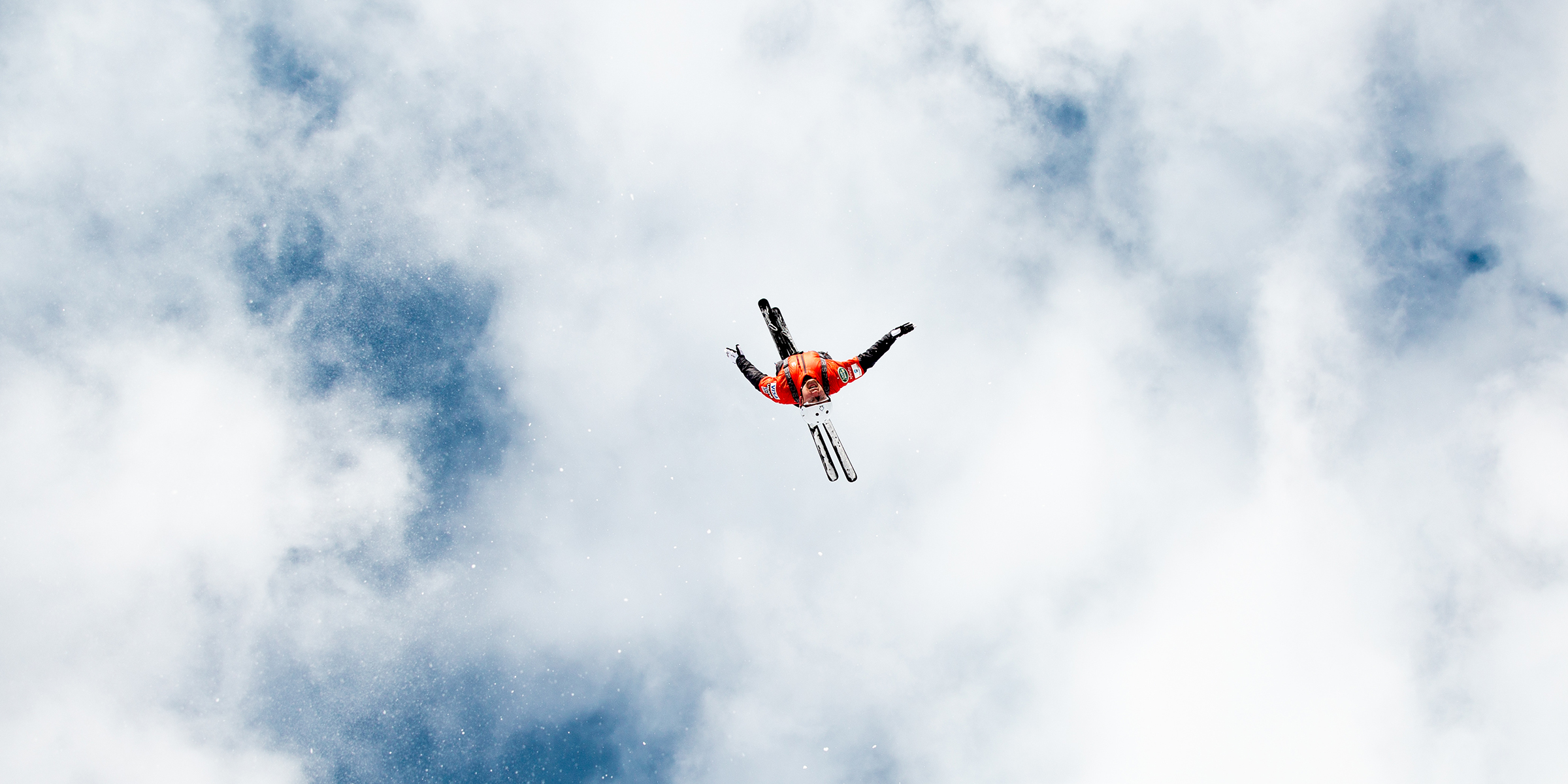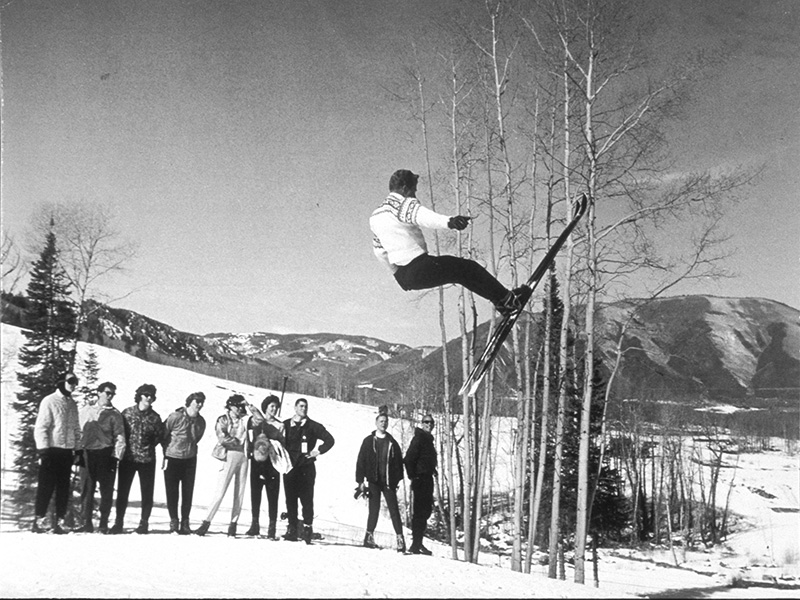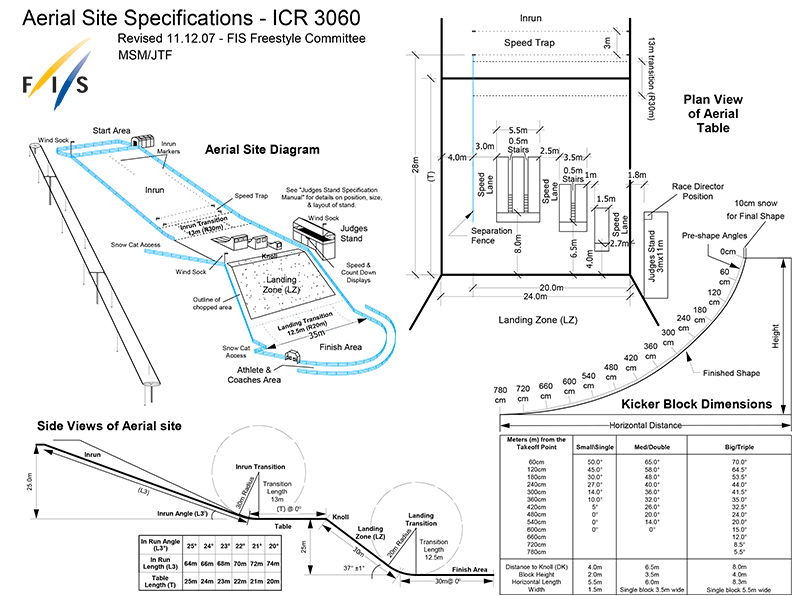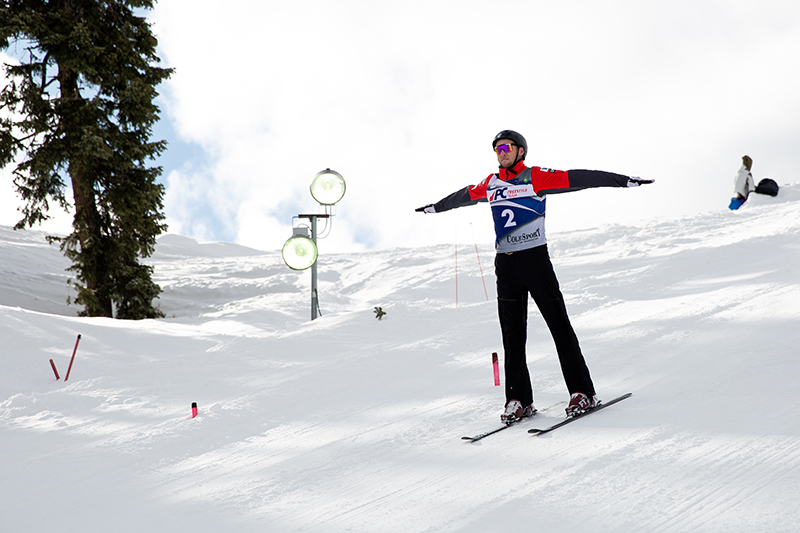Aerial Skiing 101

Are you a fan of watching aerial skiers flip and twist in the air, but have no idea how they do it? Have no fear, U.S. Ski & Snowboard is here! We have created a quick guide for all-things-aerials so that you can understand how it all works. Strap in, this will be a flipping-awesome ride!
SOME HISTORY

Aerial skiing is a discipline of freestyle skiing and was popularized in the 1950s by Olympic alpine gold medalist Steik Eriksen. Freestyle skiing was recognized by the International Ski Federation (FIS) as a sport in 1979. The first Freestyle Skiing World Cup was held in 1980 and the first FIS Freestyle World Ski Championships staged in 1986 in Tignes, France. Aerials made its Olympic debut at the 1994 Lillehammer Games. Differing from big air or slopestyle skiing, aerial skiers launch themselves straight up to do twice as many flips and twists - it’s more of a trampoline/gymnastics/diving style jump.
THE JUMP SITE

First things first, we need to get you familiar with the terrain itself. The three signature kickers, a single, double, and triple, are designed with great detail to ensure aerial skiers get enough air for flips and twists. All kickers are six to eight feet wide and are four feet thick at the top, but differ greatly in height. The difference in height corresponds with the differences in the difficulty of tricks that can be executed on each. A single kicker, which is eight feet tall, allows aerial skiers to reach about 20 feet into the air on average, which allows for two twists and one flip on average. A double kicker is 11.75 feet tall, which launches aerial skiers 30 feet into the air, allowing them up to four twists on average. The triple kicker, which is 13.5 feet tall, launches skiers 45-50 feet in the air - allowing for quintuple-twisting triple backflips.
Specific tools are used for the shaping and maintenance of these kickers. The Grizzly, which is a tool with a 10-inch blade and handle, helps keep the jump stay level and smooth. The tool’s name and origin came from a tool used in Canada to help scrape ice off the driveways. Without it, it would be much more challenging for aerial skiers to have a smooth takeoff. The cheese grater, a two-by-four version of a snowblower, is also used to run over the entire jump. This takes out any imperfections the grizzly leaves, making the kicker as clean as possible. Another key tool is the smart level. This tool gives a read of the angle that the level it is sitting at. The accuracy is strong and can get down to the 10th of a degree, which is helpful for the course builders to make sure the kicker angles remain consistent.
THE TRICKS
So now you understand what kicker aerial skiers need to go off in order to do something as impressive as a triplefull, but do you know what a triplefull is? No need to flip out, check out this master list of the basic jumps aerial skiers execute:
- Full - one flip, one twist
- Lay - one flip no twists
- Tuck - one flip no twists
- Half - one flip, half a twist
- Rudy - one flip, one and a half twists
- Randy - one flip, two and a half twists
- Adolph - one flip, three and a half twists
- Doublefull - one flip, two twists
- Pike - folded over tall, tuck folded over bent
- Triplefull - one flip, three twists
For those wondering, aerial skiers do not perform half twists unless in combinations. There is no landing switch on the knoll, as coming into the needed landing blind would be extremely dangerous. Half-twists are commonly performed on water ramps in the progression leading into learning higher twist combinations. Athletes also twist in half-combos when trampoline-ing, but only when flipping forward - again, that blind landing would be prohibitive.
In an ideal world, these flips and twists require the most pristine conditions. Weather can have a major influence on an aerial skier’s performance. If there is any wind aerial skiers have to adjust where they start on the in-run. Taller and thinner athletes have more of a disadvantage in windy conditions because they need to start further up on their in-run in order to gain enough speed. Temperature also has an impact on speed. Training during the day and then making it to finals at night provides a special challenge to aerial skiers as they try to adjust their in-run routes to the changing snow conditions. To help keep speed consistent, athletes do speed checks through a speed trap two to three times before their jump; they ideally want to be within 1k of their regular speed. Executing aerials tricks is all about consistency in speed on the in-run, the ultimate goal is to be as fast as possible so that athletes can start as close as possible to the jumps.
Believe it or not, flipping and twisting 50 feet in the air can get dangerous. Aerial skiers stay safe in the air with gear that is tailored to their discipline. Skis and bindings can add unnecessary weight, so aerial skiers prefer those made from carbon. Being as light as possible not only allows the skier to have more control, but allows their arms to have a greater influence on rotation. The ski boots used are designed to keep the skier upright and straight at all times, which causes them to have better consistency with tricks. The aerodynamic uniform is relatively snug to help with speed going into the jump, and has a straight-line design to help show the athlete’s straightness in the air. Aerial skiers also wear mouthguards to reduce concussion risk in case of a crash. The glasses, which are especially unique to aerials, are used for protection. There are no frames on the bottom of the glasses so the skier can see the ground easier for landing.
An important aspect of aerial skiing is the judging and scoring process. Aerials competition highlights the importance of take-off, height, distance, form, execution, and landing. The “air” makes up 20% of the score, the landing 30% and the “form” makes up 50%. The judges' panel, which consists of seven different judges, score different aspects of the jump. After the judges scores are in, the top score and the bottom score are discarded, leaving five scores for takeoff, form and landing. Those three scores are then added together to get a final raw score (which is out of 30). The raw score is then multiplied by the Degree of Difficulty, otherwise known as the DD, to get the final score.
THE LINGO

Feeling like an aerials pro yet? You’re almost there, but one of the most important parts of truly knowing aerials is the lingo that comes with it! Here are the meanings to the most common terms aerial skiers throw around:
- 4x4 - Four flips and four twists: full, full, full, full,
- Arched - You have an arched body position
- Getting Lost - When you get lost in the air and don’t know which way is which
- Go By - You land on your back
- Kicker Shape
- Quick - too extreme of a curve
- Flat - loading dock
- Bang On The End Of It - feels like hits you on the feet, when the end of the kicker is too steep
- KO-ed the field - When you did a really nice jump, “knocked out”
- Landing hill texture
- Mashed potatoes, sugar/brown sugar - No matter how much chopped, it doesn’t get any softer
- Broken China - If it’s warm and gets cold, chopped frozen “slush” is like broken dishes
- Lay Tuck Full - triple backflip one twist on the last flip, very common first-time triple trick, AKA “a blaster” (came from the movie Hot Dog)
- Pinned - You had nice form, “you pinned that one!”
- Punched Front - You come in too short, almost not by choice, hit, immediately fall forward into a front flip
- Scoopy - You were too rounded and hunched over
- Shaping - Shape the jump
- Stomped - Tuck the landing
- Takeoffs
- Stuffed - You were too far forward and flipping slow
- Slung - You were leaning too far back and flipping too fast
- Buckled - You were so far forward that you had to bend your knees to get the flip around
- The Daddy - full, doublefull, full
Interested in the coach’s lingo as well? The coaches play a vital role in the success of an aerial skier’s jump. Oftentimes, the coach knows if a jump is going to be executed well or not before the actual athlete does, so their shouts to the athlete are crucial for both safety and success. Here are a few of the terms a coach will yell out during a jump:
- ABS - Always be straight
- Boosty - Jump went up, trajectory high
- Dragging Hands - On landing, saving a slap back by dragging your hands
- Double-in - Doublefull on first flip
- Double-out - Doublefull on last flip
- Drift - You drifted on that one, moved laterally right to left or vice versa, when do shows need to know which way you drift
- Get There - When someone’s trying to do 4 or 5 flips, means you just have to try and flip and twist as fast as can and don’t give up until hit the ground
- Out - When to kick out of a tuck for landing because you can’t see the ground
- Pre turn - Starting to twist too early before take-off
- Pucking - Knees bent twisting
- Pull - If flipping slow and not going very high, scrunch up
- Stretch - If the aerialist is too fast or leaning back too much on takeoff, “stretch” to make the body longer and slow down flip
- Segmented - Upper and lower body not in line
- Square - symmetrical when viewed from back or front
- Through the jump - means that you buckled and slung, or trajectory is low
- Work it - pull a little bit, small and short as can without bending, pike a little bit
- Yard Sale - a crash with lost equipment spread out in the stop area
The aerial skiers of the U.S. Ski Team will compete in their first World Cup event of the 2019-2020 season on home snow Feb. 7 as part of the 2020 Intermountain Healthcare Freestyle International at Deer Valley Resort. Cheer them on as a new aerials expert and follow along the rest of their World Cup season!
